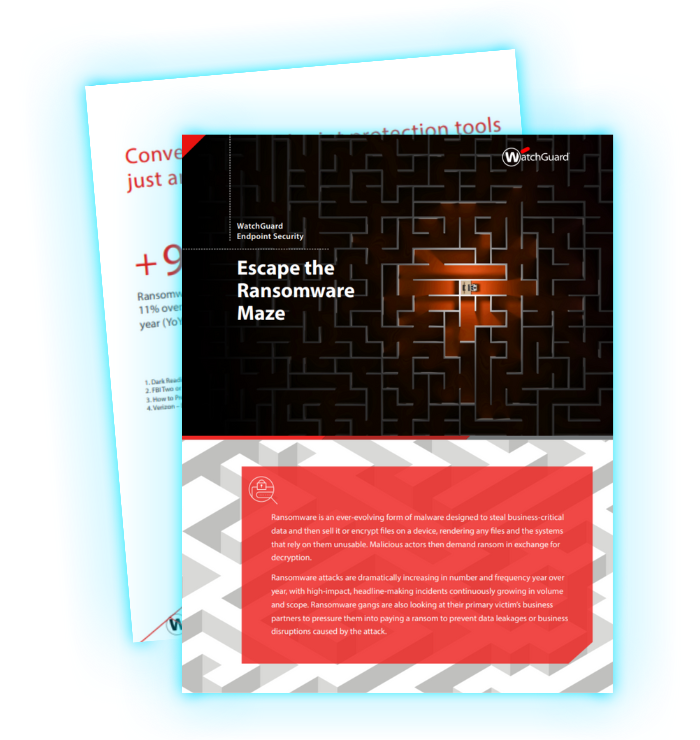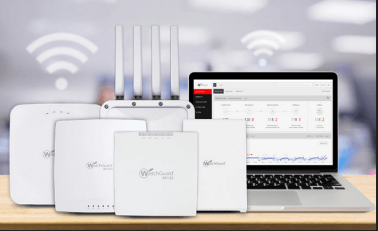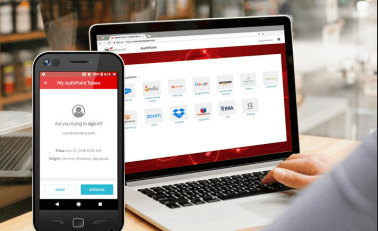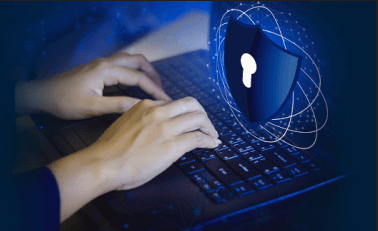

WatchGuard Endpoint Ransomware eBook
Escape the Ransomware Maze
Ransomware attacks are dramatically increasing in number and frequency year over year, with high-impact, headline-making incidents continuously growing in volume and scope. Ransomware gangs are also looking at their primary victim’s business partners to pressure them into paying a ransom to prevent data leakages or business disruptions caused by the attack.
Stopping Ransomware with WatchGuard Endpoint Security
Ransomware is an ever-evolving form of malware designed to steal business-critical data and then sell it or encrypt files on a device, rendering any files and the systems that rely on them unusable. Malicious actors then demand ransom in exchange for decryption.
- Prevent incidents before they happen
- Use a strong password manager system
- Implement multi-factor authentication (MFA)
- Anti-exploit technology
- Zero-Trust Application Service
- RDP protection
- Anti-malware technologies
- Patch to reduce the attack surface
- Anti-phishing protection
- Isolate your endpoints to contain the attack
- Apply remediation actions with ‘shadow copies’
- Activate all the prevention technologies
Lifecycle of a Ransomware Attack
Initial access
In the first stage of the attack, cybercriminals are looking to gain a foothold in the organization’s network. In most incidents, access is acquired using one of the following infection vectors: password theft, brute force, software vulnerability, or phishing. After sneaking in, the attacker will try to discover critical identities and obtain login credentials that let them keep moving forward, bypassing traditional protection.
Consolidation and preparation
Once they have gained initial access to the network, threat actors require a variety of tools to conduct the attack. They either enter with malware containing a package of all the tools necessary for the attack or, after the intrusion, they download the required tools by establishing communication with a command and control (C2) server to move forward with the next attack steps. This communication is mostly done over trusted traffic like DNS.
Lateral movement and privilege escalation
Cybercriminals move laterally within the network to find vulnerable privileged accounts. Once the attacker gets access to an account, network, or resource, they escalate the attack by leveraging that access to move through the infrastructure. In this stage, attackers typically carve themselves a path to the most critical data by breaking through security layers and gathering additional privileges.
Impact on target
In this final stage of the attack, the ransomware has been downloaded and installed on the victim’s system and now starts doing what it was designed to do. Once the attacker has disabled the system’s critical protection, it will seek to exfiltrate sensitive information on the endpoint, destroy organization backups and finally encrypt systems and data.
Ransomware attacks are growing and more sophisticated than ever. They are a sustainable and lucrative business model for cybercriminals. In some cases, it is easier and cheaper to pay the ransom than to recover from backup, but paying the ransom also does not guarantee that a victim’s files will be recovered, or the system will be accessible, and the endpoint will still be infected.
Traditional protection methods relying on malware signatures are not enough against ransomware threats. Indeed, attackers design their ransomware to bypass conventional protection layers. These threats should be managed with a comprehensive security solution that responds to the latest threats.

Network Security
WatchGuard Network Security solutions are designed from the ground up to be easy to deploy, use, and manage – in addition to providing the strongest security possible. Our unique approach to network security focuses on bringing best-in-class, enterprisegrade security to any organization, regardless of size or technical expertise.

Secure Wi-Fi
WatchGuard’s Secure Wi-Fi solutions, true game-changers in today’s market, are engineered to provide a safe, protected airspace for Wi-Fi environments, while eliminating administrative headaches and greatly reducing costs. With expansive engagement tools and visibility into business analytics, it delivers the competitive advantage businesses need to succeed.

Multi-Factor Authentication
WatchGuard AuthPoint® is the right solution to address the password-driven security gap with multi-factor authentication on an easyto-use Cloud platform. WatchGuard’s unique approach adds the “mobile phone DNA” as an identifying factor to ensure that only the correct individual is granted access to sensitive networks and Cloud applications.

Endpoint Security
WatchGuard Endpoint Security is a Cloudnative, advanced endpoint security portfolio that protects businesses of any kind from present and future cyberattacks. Its flagship solution, WatchGuard EPDR, powered by artificial intelligence, immediately improves the security posture of organizations. It combines endpoint protection (EPP) and detection and response (EDR) capabilities with zero-trust application and threat hunting services.

